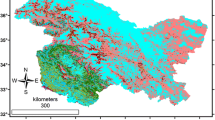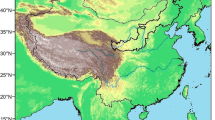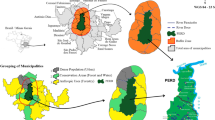Abstract
Rapidly accelerating climate change in the Himalaya is projected to have major implications for montane species, ecosystems, and mountain farming and pastoral systems. A geospatial modeling approach based on a global environmental stratification is used to explore potential impacts of projected climate change on the spatial distribution of bioclimatic strata and ecoregions within the transboundary Kailash Sacred Landscape (KSL) of China, India and Nepal. Twenty-eight strata, comprising seven bioclimatic zones, were aggregated to develop an ecoregional classification of 12 ecoregions (generally defined by their potential dominant vegetation type), based upon vegetation and landcover characteristics. Projected climate change impacts were modeled by reconstructing the stratification based upon an ensemble of 19 Earth System Models (CIMP5) across four Representative Concentration Pathways (RCP) emission scenarios (i.e. 63 impact simulations), and identifying the change in spatial distribution of bioclimatic zones and ecoregions. Large and substantial shifts in bioclimatic conditions can be expected throughout the KSL area by the year 2050, within all bioclimatic zones and ecoregions. Over 76 % of the total area may shift to a different stratum, 55 % to a different bioclimatic zone, and 36.6 % to a different ecoregion. Potential impacts include upward shift in mean elevation of bioclimatic zones (357 m) and ecoregions (371 m), decreases in area of the highest elevation zones and ecoregions, large expansion of the lower tropical and sub-tropical zones and ecoregions, and the disappearance of several strata representing unique bioclimatic conditions within the KSL, with potentially high levels of biotic perturbance by 2050, and a high likelihood of major consequences for biodiversity, ecosystems, ecosystem services, conservation efforts and sustainable development policies in the region.





Similar content being viewed by others
References
Beniston M (2003) Climatic change in mountain regions: a review of possible impacts. Clim Chang 59:5–31
Chen I-C, Shiu H-J, Benedick S, Holloway JD, Chey VK, Barlow HS, Hill JK, Thomas CD (2009) Elevation increases in moth assemblages over 42 years on a tropical mountain. Proc Natl Acad Sci U S A 106:1479–1483
Chettri N, Shakya B, Thapa R, Sharma E (2008) Status of a protected area system in the Hindu Kush-Himalayas: an analysis of PA coverage. Int J Biodivers Sci Ecosyst Serv Man 4:164–178
Corlett RT, Westcott DA (2013) Will plant movements keep up with climate change? Trends Ecol Evol (Amst) 28:482–488
Ebi KL, Woodruff R, Hildebrand A, Corvalan C (2007) Climate change-related health impacts in the Hindu Kush–Himalayas. EcoHealth 4:264–270
GEOBON (2010) Group on Earth Observations (GEOBON): Biodiversity Observation Network. Group on Earth Observations.
Hargreaves GH (1994) Defining and using reference evapotranspiration. J Irrig Drain Eng ASCE 120(6):1132–1139
Hijmans R, Cameron S, Parra J (2005) Very high resolution interpolated climate surfaces for global land areas. Int J Climatol 25:1965–1978
ICIMOD (2007) Impact of climate change on Himalayan glaciers and glacial lakes: case studies on GLOF and associated hazards in Nepal and Bhutan. ICIMOD, Kathmandu
ICIMOD (2009) Mountain biodiversity and climate change. ICIMOD, Kathmandu
ICIMOD (2010a) Kailash sacred landscape conservation initiative: first regional workshop. ICIMOD, Kathmandu
ICIMOD (2010b) Kailash sacred landscape conservation initiative: target area delineation report. ICIMOD, Kathmandu
Immerzeel WW, van Beek LPH, Bierkens MFP (2010) Climate change will affect the Asian water towers. Science 328:1382–1385
Immerzeel WW, Pellicciotti F, Bierkens M (2013) Rising river flows throughout the twenty-first century in two Himalayan glacierized watersheds. Nat Geosci Lett. doi:10.1038/NGEO1896
Jarvis A, Reuter H, Nelson A (2008) Hole-filled SRTM for the globe—version 4. Center for International Agriculture in the Tropcis (CIAT). Cali, Colombia. Available online from the CGIAR-CSI SRTM 90m website: http://srtm.csi.cgiar.org
Körner C (2007) The use of “altitude” in ecological research. Trends Ecol Evol (Amst) 22:569–574
La Sorte FA, Jetz W (2010) Projected range contractions of montane biodiversity under global warming. Proc Biol Sci 277:3401–3410
La Sorte FA, Jetz W (2012) Tracking of climatic niche boundaries under recent climate change. J Anim Ecol
Liu X (2000) Climatic warming in the Tibetan Plateau during recent decades. Int J Climatol
Liu X, Cheng Z, Yan L, Yin ZY (2009) Elevation dependency of recent and future minimum surface air temperature trends in the Tibetan Plateau and its surroundings. Glob Planet Chang 68:164–174
Maikhuri R, Rao K, Semwal R (2001) Changing scenario of Himalayan agroecosystems: loss of agrobiodiversity, an indicator of environmental change in Central Himalaya, India. Environmentalist 21:23–39
Meehl GA, Bony S (2011) Introduction to CMIP5. Clivar Exchanges 16:2–5
Metzger MJ, Schröter D, Leemans R, Cramer W (2008) A spatially explicit and quantitative vulnerability assessment of ecosystem service change in Europe. Reg Environ Chang 8:91–107
Metzger MJ, Bunce DJ, Jongman RHG, Sayre R, Trabucco A, Zomer R (2013a) A high-resolution bioclimate map of the world: a unifying framework for global biodiversity research and monitoring. Glob Ecol Biogeogr 22:630–638
Metzger MJ, Brus DJ, Bunce RGH, Carey PD, Gonçalves J, Honrado JP, Jongman RHG, Trabucco A, Zomer R (2013b) Environmental stratifications as the basis for national, European and global ecological monitoring. Ecol Indic 33:26–35
Mora C, Frazier AG, Longman RJ, Dacks RS, Walton MM, Tong EJ, Sanchez JJ, Kaiser LR, Stender YO, Anderson JM, Ambrosino CM, Fernandez-Silva I, Giuseffi LM, Giambelluca TW (2013) The projected timing of climate departure from recent variability. Nature 502:183–187
Myers N, Mittermeier RA, Mittermeier CG, da Fonseca GA, Kent J (2000) Biodiversity hotspots for conservation priorities. Nature 403:853–858
Nogués-Bravo D, Araújo MB, Errea MP, Martínez-Rica JP (2007) Exposure of global mountain systems to climate warming during the 21st Century. Glob Environ Chang 17:420–428
Olson D, Dinerstein E, Wikramanayake E (2001) Terrestrial ecoregions of the world: a new map of life on earth. Bioscience
Omernik JM (2004) Perspectives on the nature and definition of ecological regions. Environ Manag 34(Supplement 1):27–38
Ramesh KV, Goswami P (2007) Reduction in temporal and spatial extent of the Indian summer monsoon. Geophys Res Lett 34:L23704
Ramirez J, Jarvis A (2010) Downscaling global circulation model outputs: CIAT, Cali, Colombia
Schild A (2008) ICIMOD’s position on climate change and mountain systems. Mountain Research and Development
Scholes RJ, Mace GM, Turner W, Geller GN, Jurgens N, Larigauderie A, Muchoney D, Walther BA, Mooney HA (2008) Toward a global biodiversity observing system. Science 321:1044–1045
Scholes RJ, Walters M, Turak E, Saarenmaa H, Heip CHR, Tuama ÉÓ, Faith DP, Mooney HA, Ferrier S, Jongman RHG (2012) Building a global observing system for biodiversity. Curr Opin Environ Sustain
Sharma E, Chettri N, Tse-ring K, Shrestha AB, Jing F, Mool P, Eriksson M (2009) Climate change impacts and vulnerability in the Eastern Himalayas. ICIMOD, Kathmandu
Sharma E, Chettri N, Oli KP (2010) Mountain biodiversity conservation and management: a paradigm shift in policies and practices in the Hindu Kush-Himalayas. Ecol Res 25:909–923
Shrestha UB, Gautam S, Bawa KS (2012) Widespread climate change in the himalayas and associated changes in local ecosystems. PLoS One 7:e36741
Singh SP, Bassignana-Khadka I, Karky BS, Sharma E (2011) Climate change in the Hindu Kush-Himalayas: the state of current knowledge. ICIMOD, Kathmandu
Thuiller W (2007) Biodiversity: climate change and the ecologist. Nature 448(7153):550–552. doi:10.1038/448550a
Tingley MW, Monahan WB, Beissinger SR, Moritz C (2009) Birds track their Grinnellian niche through a century of climate change. Proc Natl Acad Sci U S A 106(Suppl 2):19637–19643
TISC/MOFSC (2002) Forest and vegetation types of Nepal. His Majesty’s Government of Nepal, Ministry of Forest and Soil Conservation, Department of Forests, Tree and Improvements and Silviculture Component (TISC Document Series No. 104), Kathmandu
Tou JT, Conzalez RC (1974) Pattern recognition principles. Addison-Wesley Publishing Company, Reading, Massachusetts
van Wart J, van Bussel LGJ, Wolf J, Licker R, Grassini P, Nelson A, Boogaard H, Gerber J, Mueller ND, Claessens L, van Ittersum MK, Cassman KG (2013) Use of agro-climatic zones to upscale simulated crop yield potential. Field Crops Research 143:44–55. doi:10.1016/j.fcr.2012.11.023
Vuuren DP, Edmonds J, Kainuma M, Riahi K, Thomson A, Hibbard K, Hurtt GC, Kram T, Krey V, Lamarque J-F, Masui T, Meinshausen M, Nakicenovic N, Smith SJ, Rose SK (2011) The representative concentration pathways: an overview. Clim Chang 109:5–31
Xu J, Shrestha A, Vaidya R, Eriksson M, Hewitt K, Jianchu X, Shrestha A, Vaidya R, Eriksson M, Hewitt K (2007) The melting Himalayas: regional challenges and local impacts of climate change on mountain ecosystems and livelihoods. International Centre for Integrated Mountain Development (ICIMOD)
Xu J, Grumbine R, Shrestha A (2009a) The melting himalayas: cascading effects of climate change on water, biodiversity, and livelihoods. Conservation Biology 23(3):520–530
Xu J, Shrestha A, Eriksson M, Braun L, Severskiy WHIV, Young G (2009b) Climate change and its impacts on glaciers and water resource management in the Himalayan Region. Assessment of snow, glacier and water resources in Asia 44–54
Zomer RJ, Oli KP (2011) Kailash sacred landscape conservation initiative: feasibility assessment report. ICIMOD: Kathmandu. SBN: 978 92 9115 211 7
Zomer R, Trabucco A, Bossio D et al (2008) Climate change mitigation: a spatial analysis of global land suitability for clean development mechanism afforestation and reforestation. Agriculture
Zomer RJ, Trabucco A, Oli KP (2013) Environmental stratification and projected climate change impacts on ecosystems in the Kailash Sacred Landscape of China, India, Nepal. ICIMOD, Kathmandu
Zomer RJ, Trabucco A, Wang M, Rong L, Chen H, Metzger M, Smajgl A, Beckshafer P, Xu J (2014) Environmental stratification to model climate change impacts on biodiversity and rubber production in Xishuangbanna, Yunnan, China. Biol Conserv 170:264–273
Acknowledgments
The study supports the goals and requirements of the Kailash Sacred Landscape Conservation and Development Initiative (http://www.icimod.org/ksl), the KSL Conservation Strategy, and the KSL Comprehensive Environmental Monitoring Plan. The authors would like to acknowledge the many efforts that have gone into the KSLCI, and the many people that have contributed to provide the background information for this study. In particular we acknowledge the pivotal role of the International Centre for Integrated Mountain Development (ICIMOD) in Kathmandu, Nepal, and the lead partner organizations, namely the Institute for Geographic Research and Resources, Chinese Academy of Sciences, G.B. Pant Institute for Himalayan Environment and Development of India, and the Central Institute of Botany, Tribuhvan University, Nepal. The research paper has been financially supported by the National Key Basic Research Program of China (Grant No. 2014CB954100) and the IDRC- supported project on “Building Effective Water Governance in the Asian Highlands”. Additional support was also provided by the CGIAR Research Program 7: Climate Change, Agriculture and Food Security (CCAFS). We also thank German Technical Cooperation (GIZ), particularly Mr. Roman Röhrl for his personal unwavering support, the German Ministry of the Environment (BMZ) for supporting the early stages this research, and the Kunming Institute of Botany, Chinese Academy of Sciences for technical support and expertise. Many thanks to Dr. Robert Hijmans of the University of California–Davis for providing the downscaled CIMP5-ESMs. The authors would like to thank the editors and anonymous reviewers for their valuable comments and suggestions that have improved both the analysis and this paper. Finally, we'd like to thank the other members of the joint Russian-American field expedition to Kailash (2009), Deborah Bossio, Maya Zomer, Satya Zomer, and Uliana Sotnikova, for their joyful efforts and support.
Author information
Authors and Affiliations
Corresponding author
Electronic supplementary material
Below is the link to the electronic supplementary material.
ESM 1
(DOCX 3158 kb)
Rights and permissions
About this article
Cite this article
Zomer, R.J., Trabucco, A., Metzger, M.J. et al. Projected climate change impacts on spatial distribution of bioclimatic zones and ecoregions within the Kailash Sacred Landscape of China, India, Nepal. Climatic Change 125, 445–460 (2014). https://doi.org/10.1007/s10584-014-1176-2
Received:
Accepted:
Published:
Issue Date:
DOI: https://doi.org/10.1007/s10584-014-1176-2




